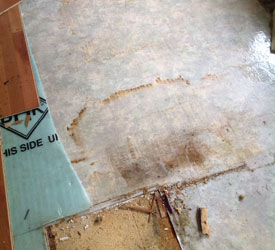Are you currently interested in help and advice about Looking for Signs of Water Damage in the Bathroom?

The shower room is exceptionally at risk for moist accumulation as well as possible water damages due to the frequent use of water in it. This article provides easy assessment strategies to aid detecting water damage hazards.
The frequent use of water in the shower room makes it very at risk for moist accumulation and potential water damage. By examining it frequently, you can minimize water associated problems.
The adhering to collection of examinations is very easy to execute and also need to be done as soon as in every 3 months in order to maintain your washroom healthy and also to stop possible water problems triggered by the tub, the shower, pipe joints and plumbing, sinks, cabinets, and the commode
Do not disregard doing these evaluations and be thorough while executing them. Remember that these easy assessments can save you a lot of money by giving very early indicators for water damage
Sinks and also Cabinets
Sinks as well as cabinets are revealed to dampness as well as humidity day-to-day as well as are frequently forgotten. Check routinely under the sink and also on the counter top above it. Fix any type of drip in the catch as it might suggest drainpipe issues. Look around the sink, slow-moving draining pipes might suggest a blocked drainpipe. Change sink seals if they are split or loosened.
Bathtub as well as Shower
The shower and bath tub need unique interest and upkeep. Check the floor tiles as well as change if broken. Make sure that there is no missing grout in between the ceramic tiles. Inspect as well as change broken caulking at joints where the wall surfaces satisfy the flooring or the tub. Obstructed drains as well as pipes issues will stop the bath tub from drying as well as might indicate major troubles beneath the tub. Seek advice from a professional instantly to prevent architectural damage. Take note of stainings or soft locations around the tub wall surfaces as they may suggest an inner leak.
Plumbing
Signs for water damage are tough to spot considering that most pipes are mounted inside the walls.
Pay special focus to flooring as well as wall surfaces moisture as well as spots as they might indicate an undetectable plumbing issue. Examine moisture levels in adjoining spaces too.
The Toilet
The bathroom is a prone water joint. Examine the water lines and search for leakages around the commode seat, in the hose, as well as under the water container. If you identify any indications of dampness on the flooring around the toilet, check for leaks in the toilet edge as well as container seals.
Be aware that hanging toilet bowl deodorants boosts the opportunities for obstructions.
Water Damage Signs In The Bathroom To Avoid Cleanup
Musty smell
This is one of the easiest signs to catch because musty smells are so odorous. The damp, earthy, moldy smell should be a big red flag. The smell will develop when moisture gets trapped in surfaces, and begins to facilitate mold growth. Leaking pipes under cabinets, inside walls, and behind shower fixtures will cause moisture to stay trapped and not dry, which will lead to mold growth and spread. As soon as you notice any musty smells in your bathroom, have it checked for hidden water damage and cleanup signs.
Visible mold
If the smell isn’t there to give it away, sometimes you will actually see mold growth. Finding mold in your bathroom is a serious problem, because mold is very harmful to your health. By the time mold growth is visible, it also means that water damage has already occurred and been present for some time. The only way the mold problem can be resolved is to find the source of the moisture and get it stopped. To safely and adequately remove mold, you need to have professionals handle the remediation. Do not waste any time in getting mold problems addressed, fixed, and sanitized so that you can protect you and your family from the many respiratory symptoms caused by mold exposure.
Damaged floors
Bathroom floors should be able to withstand some exposure to water while still remaining in good condition. However, when excess exposure or water leaks occur, they will begin to damage even the most water-resistant flooring. If you notice any cracking, bubbling, staining, or warping on your bathroom floors, there is probably a water leak somewhere causing the distortion. If you notice areas of the floor have become softer, or even have a spongy feeling, there is probably damage to the subfloor. Subflooring is typically made up of plywood. When plywood is exposed to water or moisture, it will absorb it. Once it has become saturated, the weight of the excess water will cause the wood to swell and soften. Check the floors in your bathroom frequently to catch any of these sings before they lead to damaged subflooring.
Changes on walls
When water leaks behind walls, it will cause changes in the drywall. Peeling plaster, blistering paint, and soggy wallpaper are all good indicators that excess water is building up behind the wall. Water leaking behind drywall will cause it to swell and be soft to the tough. If you start to notice gaps along the trim of your walls, or where tile meets the wall, it could also be a strong indicator that there is a leak behind the wall. Any changes, distortion, or damage on the walls should be evaluated as soon as you notice it to prevent further water damage and cleanup.

We are very taken with How to Repair and Prevent Bathroom Water Damage and I really hope you enjoyed reading my page. Do you know another individual who is interested in Looking for Signs of Water Damage in the Bathroom? Please feel free to share it. We cherish reading our article about Preventing Water Damage in the Bathroom.
Details Here